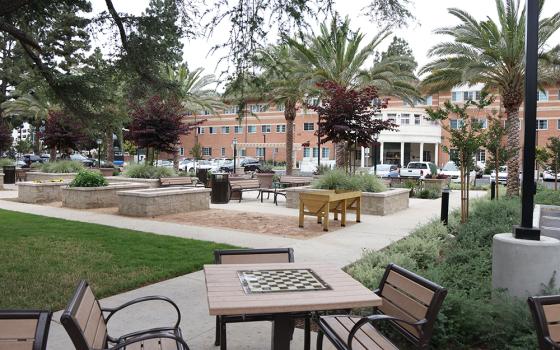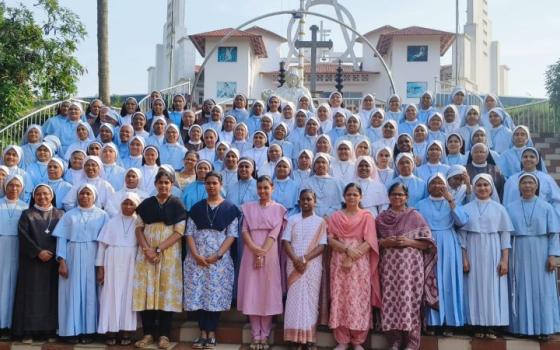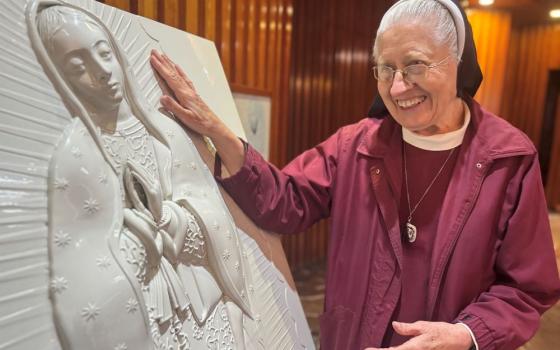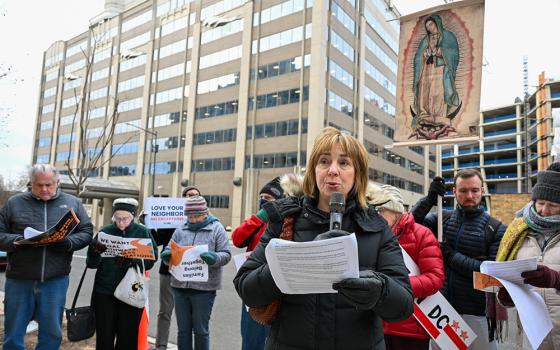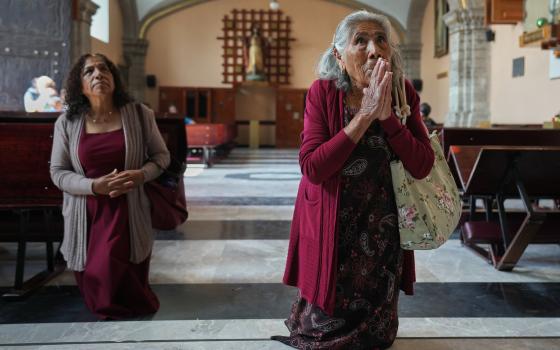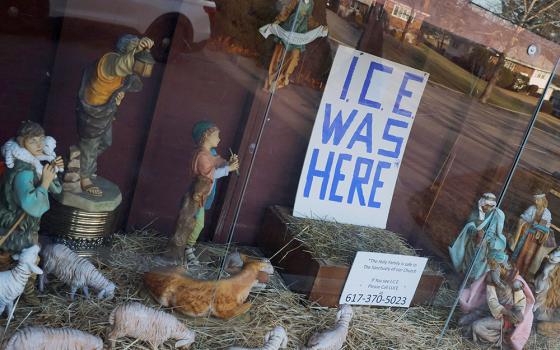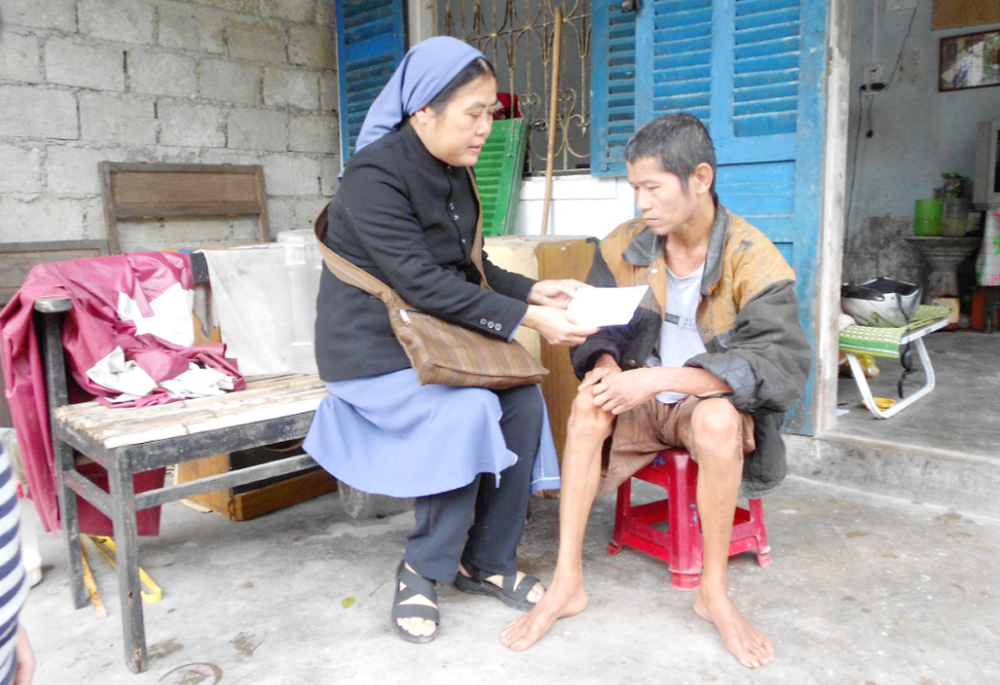
Daughters of Our Lady of the Visitation Sr. Mary Pham Thi Phu offers gifts to a man in Phu Loc District in Thua Thien Hue province on April 19. Their community's ministry includes supporting people affected by Agent Orange and landmines left behind after the Vietnam War. (GSR photo)
After enduring years of hardship and surveillance under a communist government, Catholic sisters in Vietnam are continuing a remarkable resurgence: rebuilding ministries, reclaiming property and expanding far beyond their war-torn homeland.
The nearly 20-year Vietnam War ended April 30, 1975, when Northern communist tanks rolled into Saigon, the capital of the U.S.-backed South Vietnam. During two decades of bloodshed, North Vietnam's communist region nationalized, "borrowed" or shut down nearly all church-run institutions — seminaries, schools, hospitals, orphanages, banks and even convents.
Vietnam's turning point came in 1986 when the government launched its Doi Moi reforms to rescue its struggling, centrally planned economy. These sweeping changes introduced market-oriented policies, opened the country to global trade, eased religious restrictions and set the stage for normalized relations with the United States in 1995.
Since then, the former foes have forged a comprehensive strategic partnership. By 2024, bilateral trade surpassed $132 billion, and cooperation broadened to include technology, education, health care, human rights, environmental protection and regional security.
These reforms created an opening for religious life to reemerge. Catholic sisters gradually reconnected with local communities, resumed formation programs and reengaged in public ministry.
Sr. Consolata Bui Thi Bong, former superior of the Daughters of Mary of the Immaculate Conception, recalled how the congregation began to reemerge in the early 1990s.
She said that with permission from local government authorities, sisters teamed up with state-employed doctors to open the Kim Long Charity Clinic in 1992, offering health care to the poor who couldn't access public hospitals. In 2005, they collaborated with other congregations and Buddhist volunteers to care for people with HIV/AIDS who were left to fend for themselves.
Their biggest breakthrough came in 1994, she said, when Archbishop Stephen Nguyen Nhu The, appointed by Pope John Paul II to the Vatican's interreligious council, persuaded the government to return the nuns' motherhouse. A military regiment had requisitioned their convent lot as barracks.
"We were overjoyed," Bong said. "It felt like a miracle."
Young women gather to learn about religious vocations at a convent of the Daughters of Mary of the Immaculate Conception in Hue on August 6, 2023. (GSR photo)
The sisters and their lay supporters spent three months clearing the building, which was in disrepair after nearly two decades of military use.
The National Shrine of Our Lady of La Vang has also since been restored.
In 1993, the government permitted the election of a new superior for the first time since 1975, ending Sr. Marie Gonzague Do Thi Tung's 20-year tenure. Tung died in 2017 and is remembered for her perseverance during years of oppression.
Bong said that by 1997, the sisters were running an informal preschool for local children. The government only formally recognized it in 2002. Today, it serves 400 students, including children of government officials, she said.
At that time, sisters who had fled returned to rebuild their motherhouse, reestablish parish-based communities and launch new ones in other dioceses.
"The moment we were allowed to recruit new vocations publicly in 1997, we moved quickly," Bong said. By 2000, sisters were also being sent abroad for pastoral studies, she said.
The octogenarian nun said that earlier this year, the order established a new community in Tampa, Florida — their third in the U.S. They also have foundations in Richmond, Virginia and Silver Spring, Maryland, started in 2005 and 2009, respectively.
The 105-year-old congregation, she said, now has 510 sisters in 58 communities in 11 dioceses throughout Vietnam. Their ministries include catechism, basic education, housing and scholarships for war-affected children, health care for the sick and disabled, and pastoral outreach to the poor.
The chapel and motherhouse of the Daughters of Mary of the Immaculate Conception is see in Hue on April 14, 2025. Vietnam's communist government seized their convent during the war to use as barracks. It was returned to the congregation in 1994. (GSR photo)
Other congregations have also resurfaced. In 1996, she said, Discalced Carmelites from Ho Chi Minh City were allowed to return to their monastery in Hue after over two decades. Since then, they've founded three new communities in Ho Chi Minh City, Xuan Loc and Hai Phong.
"After half a century of displacement, we've seen steady growth," Bong said.
Sr. Mary Nguyen Thi Tuyet, a member of the advisory board of the Lovers of the Holy Cross of Hue, said the sisters had to shift their focus after losing all their facilities. Their new ministries include feeding hospital patients, supporting visually impaired people and single mothers, burying aborted fetuses, and helping poor students access education.
"These ministries teach us humility, simplicity and closeness to the people," Tuyet said.
The 83-year-old nun said that in 1996, two sisters finally got permission to study abroad — a long-awaited milestone.
Tuyet said that today their congregation includes 493 nuns and 22 novices, with ministries in orphanages, boarding houses, social services and trauma therapy programs. They also run nine communities in France, Italy and the U.S.
The sisters displaced in 1975 later helped form new branches of the Lovers of the Holy Cross of Phan Thiet and Ba Ria in 1984 and 2008, respectively, Tuyet said.
According to Sr. Lucia Bui Thi Hiep from the Lovers of the Holy Cross community in Ha Tinh, as of July 2024, Vietnam is home to 24 Lovers of the Holy Cross congregations under diocesan administration, with a total of 10,127 sisters and 816 novices.
Sr. Anna Le Thi An (right) and other sisters attend a ceremony in Hue in May 2024. She joined the Daughters of Our Lady of the Visitation in 1969, six years before the Vietnam War ended. (GSR photo)
Sr. Anna Le Thi An, who joined the Daughters of Our Lady of the Visitation in 1969, recalled starting new communities in the 1990s in the dioceses of Da Nang, Nha Trang and Ho Chi Minh City. Their congregation also sent five sisters to study theology, Scripture and canon law in France, the U.S. and Australia. She added that the congregation now has 31 domestic communities and three overseas.
An said that former sisters who left to marry now serve with them in lay ministries.
"We've learned to endure and place our trust in God's providence," An said. "What once seemed like a loss became an opportunity."
Their outreach includes working with people of other faiths, assisting the elderly and people with disabilities, teaching informal classes, and supporting war victims affected by Agent Orange and landmines left behind.
Advertisement
St. Paul de Chartres Sr. Marie Monique Van Thi Thuc of Da Nang said only one of their 35 former properties was returned since the war. They now use property, previously used as a police station, as a child care center.
Their 570 sisters serve in eight dioceses, caring for leprosy and HIV/AIDS patients, children with disabilities and disaster victims.
Daughters of Mary of the Immaculate Conception Sr. Marie Hélène Do Thu Hang entered religious life in 1996. Today, she teaches at a day care in Hue.
"We've built new convents, clinics, schools and homes for the elderly," she said. "Our sisters are studying abroad, working in public hospitals, and partnering with NGOs on climate change and HIV/AIDS."
"Vocations come from God," the 50-year-old nun added. "He calls us to bring the Good News to others. If we say yes, He'll do the rest."
